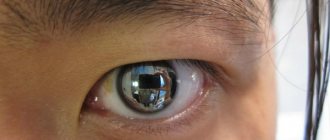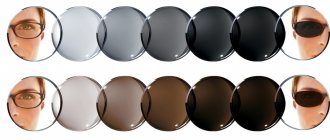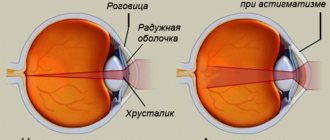Experts call astigmatism an abnormality of the eye, which consists in the fact that the radius of curvature of the cornea in different meridians is not the same. That is, in patients suffering from this disease, the focusing of rays on the retina of the eye is impaired, which leads to image distortion. Most often, the disease is caused by an irregularly shaped cornea. Treatment of this disease with lenses is currently not only very popular, but also quite effective. Astigmatic contact lenses perform the same function as glasses, namely, they refract and focus light rays for a better picture. When choosing this type of lenses, consultation with an ophthalmologist is necessary. It is worth considering that there are several types of contact lenses for astigmatism correction and each has its own advantages.
A little about astigmatism
Astigmatism is an eye disease or a defect of such a nature that a person sees the world around him, or rather, the objects surrounding him, somewhat distorted or, depending on the distance to them, partially blurred. With this pathology, light rays that should converge at one point on the retina are unable to do so . That is, the image is not formed as a point, but in the shape of a figure eight, ellipse or segment.
Astigmatism
Pathology can appear at absolutely any age, but most often at an early age. It often accompanies people with other visual impairments - for example, myopia.
Attention! Untreated astigmatism can cause strabismus to develop and also cause a sharp deterioration in the quality of vision. If this pathology is not corrected with the help of correction means, then a person may suffer from pain in the eyes and migraines.
Eye astigmatism
The symptoms of the disease are as follows:
- images of objects are distorted, double;
- eyes get tired quickly;
- headaches may appear.
Types of astigmatism
In some ways, the symptoms are similar to myopia or farsightedness. That is, objects at a long distance appear blurry to a person. And even at close range, if you have astigmatism, it becomes difficult to read or sew, as well as do some things that require a close, attentive gaze. Astigmatism can be divided into three types:
- farsighted complex;
- myopic complex;
- mixed.
Astigmatism. What it is
Diagnosis is carried out after instilling drops containing atropine into the eyes, after which the pupil dilates, and then a so-called shadow test (skiascopy or refractometry) is performed. Visometry and keratotopography are also performed.
Astigmatism can be detected by taking a figurine radiata test.
Radiant figure for dough
On a note! An accurate diagnosis and data on the degree of astigmatism can only be made in an ophthalmologist’s office, where there is special equipment for this.
A test to determine pathology at home is carried out as follows:
- it is necessary to wear glasses or contact lenses if a person wears them;
- then you need to place your eyes approximately 35 cm from the image used for the test, displayed on the monitor or printed;
- after this, it is enough to examine the image with one eye, covering the other with something;
- It is important to evaluate how clearly all the lines are visible, and then repeat the test for the second eye, closing the first.
Simple test for astigmatism
If some of the lines appear blurry or faded during testing, then the likelihood of astigmatism is high, and you need to visit an ophthalmologist as soon as possible.
A little about the disease
It is necessary for the patient to know that vision does not focus due to improper image display on the retina. The problem is the distorted shape of the cornea and lens.
IMPORTANT: to establish such a diagnosis, it is necessary to undergo an experimental examination: refractometry, keratotopography, “shadow test”, ultrasound of the eyes and biomicroscopy.
When checking, two meridians are revealed with refraction into acute and obtuse angles. The greater the refractive angle, the higher the degree of astigmatism. If the disease does not progress, then astigmatism is called correct. Astigmatism is called irregular if the main meridians are not located at an angle of 90° or the disease progresses.
Why does it happen?
Astigmatism occurs in two cases:
- Congenital. Most often this occurs due to an abnormally shaped cornea or lens.
- Acquired. After operations performed on the eye, accidents, injuries, some diseases of the cornea.
What is the difficulty of correction?
Astigmatism can only be corrected with glasses or contact lenses. The doctor takes into account the stage and type of anomaly. A mild degree can be corrected with cylindrical glasses or lenses with an aspherical shape. Complex degrees of the disease can only be corrected by toric lenses.
Cylindrical lenses can cause complications, and people with nearsighted astigmatism may see double the image. With farsightedness, on the contrary, the rays are scattered behind the retina.
Contact lenses for astigmatism
A vision defect such as astigmatism can be corrected with glasses or contact lenses, which have recently come into use. However, most people now avoid the first option, considering glasses to be unattractive and spoiling their overall appearance. That's why they choose lenses. Undoubtedly, these correction means have many advantages, but they are not without disadvantages.
Contact lenses for astigmatism
Advantages of using lenses for correction:
- convenient and quite easy to use;
- do not overstrain the eyes;
- do not fog up when the temperature changes;
- don't break.
Flaws:
- If you do not care for your lenses properly, inflammatory processes may develop;
- the patient may experience discomfort;
- sometimes the quality of vision may deteriorate if low-quality lenses are used (tissue oxygen starvation may occur);
- the shape of the cornea may change.
Lenses are more comfortable than glasses
To correct astigmatism, so-called toric lenses are used. They have a special shape and surface, which can be either on their front or back. The spherocylindrical shape allows you to obtain different optical power indicators in the horizontal and vertical, which allows you to correct astigmatism and other defects in the quality of vision at the same time. With the help of such lenses with a toric coating in the anterior part, both lens and corneal astigmatism can be corrected up to 4.5 D. And if the toric surface is located in the back, then corneal astigmatism with a value of 6.0 D is corrected.
Spherical and toric lenses
On a note! Toric lenses are also called torics or abbreviated as TCL.
There are a variety of lenses that can be used to correct astigmatism. So, for example, they can be both colored and colorless, day and night, flexible, etc. There are also soft and hard lenses. The first ones themselves are much more comfortable than hard ones, and they are easier to wear - they rarely fall out of your eyes. But soft ones deteriorate faster, can dry out, becoming brittle, and they are also an excellent environment for the development of colonies of microorganisms.
Soft toric lenses
Table. Types of TCL lenses by duration of wearing period.
| Type | Brief Explanation |
| Daytime | Remove at night and put into a container. Wearing is indicated only during the day. |
| For long-term wear | You can wear these lenses for a week without worrying about having to take them out. |
| Flexible | You can wear these lenses for about 2-3 days without removing them. |
| Permanent | This type of lens can be worn for a whole month. |
Toric lenses can be made from silicone hydrogel or hydrogel, as well as special organic glass. In the first cases, products with good gas permeability are obtained. Rigid lenses are usually used for severe, difficult-to-correct vision problems.
There are different types of toric lenses
On a note! To correct minor astigmatism, you can use the most common lenses. The main thing is that the pathology does not progress.
List of the best manufacturers
Air Optix for astigmatism
Contact lenses developed using the Precision Balance 8/4 Design method. The peculiarity of these lenses is that they are somewhat thicker at the bottom, due to which they adhere quite tightly to the surface of the cornea. Designed to correct mild astigmatism, however, with appropriate selection, you can find lenses that would correct any visual impairment from 6 to -12 diopters. It is not recommended for beginners to buy them, as they are thick and hard to get used to. However, for those who are familiar with lenses first-hand, this option is suitable. They can be worn for up to six months.
Biofiniti Toric
Toric lenses that correct severe astigmatism. The service life of these lenses is relatively short - only one month. They are practically not felt on the eyes while wearing. An interesting feature of these lenses is that they are made of silicone hydrogel, that is, they are permeable to air. This is why they are ideal for people who have previously only used glasses: they are very easy to get used to. They have only one drawback - high cost.
Acuvue Oasys for Astigmatism
Another option for silicone hydrogel lenses. Somewhat cheaper than the previous analogue, however, their service life is only fourteen days, after which they require replacement. Taking into account the fact that they are not much cheaper than the previous ones, it is not advisable to buy them, since in terms of conversion the price is approximately the same. Allows you to completely correct low to moderate astigmatism.
Acuvue Moist for Astigmatism
Cheap daily lenses. They can be used if a person suffering from astigmatism needs to avoid using glasses for some time. They are produced in special hermetic packaging and do not require preparation for use or care products. Despite the fact that they are also silicone hydrogel, their oxygen throughput is quite low due to the lack of need for daily wear.
Biomedics toric
Lenses that can be worn for one month. They do not allow oxygen to pass through well, however, each pair is inexpensive. Unfortunately, they are only sold in sets of six lenses, which can create some inconvenience if the first one doesn't fit. The shape of these lenses is outdated, which can cause them to shift or fall out completely. They allow you to correct low and moderate astigmatism, however, it is not recommended to use them unless absolutely necessary - the risk of hypoxic damage to the cornea is too high.
Lens selection
Selecting lenses in the presence of a pathology such as astigmatism is much more difficult than in cases of banal myopia. The fact is that to correct the latter, it is enough to clarify the diopter value and you can go to the nearest optician for lenses. But with astigmatism, it is important to know a number of other parameters that only a doctor can determine. It is important to know the axis and strength of the cylinder, the radius of curvature and a number of other indicators. It is also important to determine lens stabilization. It should clearly “sit” in one place and not move when worn.
Selection of contact lenses
Attention! Toric lenses should always be in the same position on the eye. Only through this will they give the desired effect. To ensure that the lens always sits correctly on the eye, various techniques are used, such as truncating the lens or creating a certain ballast, which makes the lens heavier and thicker.
For the first half hour, toric lenses are worn in order to determine whether they are comfortable, whether they cause inconvenience, etc. After this, the doctor writes out a prescription, and you can buy the lenses you need for constant wear. Usually adaptation to TCL occurs quite quickly.
Table. The main factors that are important to consider when choosing lenses.
| Designation | Decoding |
| D | This is the optical correction power, otherwise known as visual acuity. Indicated in diopters, it can be negative or positive. |
| Bc | The radius of curvature is indicated in millimeters. |
| Cyl | Astigmatic power, which can be negative or positive, is indicated by diopters. |
| Dia | The diameter of the cornea or its size. Measured in millimeters. |
| Ax | The location of the defect, the indicator is measured in degrees. |
| Design | This is a type of stabilization. Indeed, it is marked in the lens prescription as a design. |
Rules for choosing lenses
Where to buy cheaper
Astigmatic contact lenses should only be fitted by an experienced doctor for the first time. You should not search for cheap lenses on your own; it is better to go to the nearest optician, where they will make a professional selection of glasses for you. Experienced ophthalmologists usually work there and will immediately tell you what lenses are needed. To get started, purchase what they recommend to get sample packaging and instructions. Subsequently, you can independently search for the same ones in online stores at a much lower price - such as Ochkov.Net, Magazinlens, Ochkarik, my eyes, or order on Aliexpress.
How to use contact lenses
Step 1: It is important to choose the right contact lenses. They must be optimal in terms of wear time, comfort and quality. In particular, lenses for astigmatism must be chosen by an ophthalmologist; this cannot be done independently.
Choose your lenses correctly
Step 2. You should familiarize yourself with the existing types of lenses and manufacturers. But any decision you make should be discussed with your doctor.
Be sure to talk to your doctor
Step 3. It is important to learn how to put on lenses correctly. The first time it is better to do this in the ophthalmologist’s office - the specialist will tell you and show you how to do everything correctly.
Learn to put on lenses correctly
Step 4. Different types of lenses require different care. This process also needs to be learned and not forgotten to be put into practice. The overall health of your eyes depends on the cleanliness of your lenses.
Take proper care of your lenses
Step 5: Before any contact with your lenses, it is important to wash your hands thoroughly with antibacterial soap. Especially when it comes to manual lens cleaning.
Wash your hands before touching lenses
Step 6. Under no circumstances should you put on someone else’s lenses, even out of idle curiosity. You can get an infection.
Don't wear other people's lenses
Step 7. It is required to undergo regular examination by a doctor and note the dynamics of changes in vision.
Visit your doctor regularly
Are there any disadvantages?
Despite a number of the advantages listed above, there are also some disadvantages that are inherent in contact lenses used to treat astigmatism:
- In some patients, when regularly wearing contact lenses, inflammatory processes occur. This is due to the increased thickness of a large number of toric contact lenses, which cause discomfort to the patient and cause long-term addiction to them.
- Some types of hard lenses lead to chronic oxygen deficiency of the cornea, as a result of which the patient experiences an increase in myopia.
- Long-term use of soft contact lenses can subsequently lead to changes in the shape and topography of the cornea.
Considering the disadvantages discussed above, it is advisable to undergo an examination from an ophthalmologist from time to time in order to avoid the development of any deviations when using contact lenses. Further selection of contact lenses and treatment with their help is carried out only after diagnostic measures.









